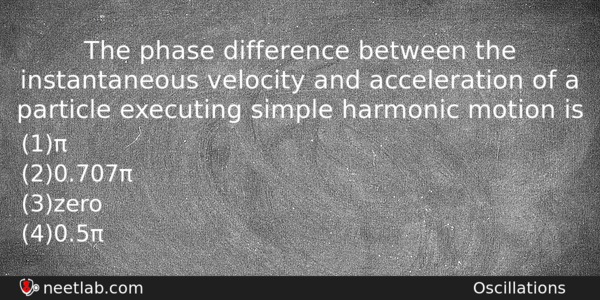| ⇦ | 
| ⇨ |
The phase difference between the instantaneous velocity and acceleration of a particle executing simple harmonic motion is
Options
(a) π
(b) 0.707π
(c) zero
(d) 0.5π
Correct Answer:
0.5π
Explanation:
Let y = A sin ωt
vinst = dy/ dt = Aω cos ωt
vinst = Aω² sin (ωt + π/2)
Acceleration = – Aω² sin ωt = Aω²sin (π + ωt)
ɸ = π/2 = 0.5 π.
Related Questions: - A heavy uniform chain lies on a horizontal top table.If the coefficient of friction
- Two radiations of photons energies 1 eV and 2.5 eV, successively
- A fluid is in streamline flow across a horizontal pipe of variable area of cross section
- Consider a compound slab consisting of two different materials having equal thickness
- The condition under which a microwave oven heats up a food item containing
Topics: Oscillations
(58)
Subject: Physics
(2479)
Important MCQs Based on Medical Entrance Examinations To Improve Your NEET Score
- A heavy uniform chain lies on a horizontal top table.If the coefficient of friction
- Two radiations of photons energies 1 eV and 2.5 eV, successively
- A fluid is in streamline flow across a horizontal pipe of variable area of cross section
- Consider a compound slab consisting of two different materials having equal thickness
- The condition under which a microwave oven heats up a food item containing
Topics: Oscillations (58)
Subject: Physics (2479)
Important MCQs Based on Medical Entrance Examinations To Improve Your NEET Score
18000+ students are using NEETLab to improve their score. What about you?
Solve Previous Year MCQs, Mock Tests, Topicwise Practice Tests, Identify Weak Topics, Formula Flash cards and much more is available in NEETLab Android App to improve your NEET score.
Share this page with your friends

Leave a Reply